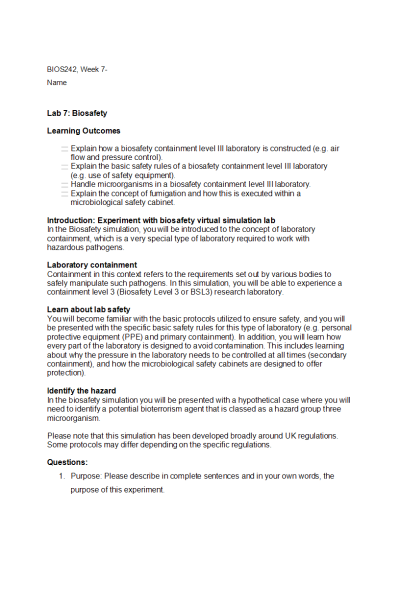BIOS 242 Week 7-OL, Lab 7; Biosafety
-
$15.00
| Institution | BIOS 242 Fundamentals of Microbiology with Lab |
| Contributor | elizabeth Oslen |
Learning Outcomes
- Explain how a biosafety containment level III laboratory is constructed (e.g. air flow and pressure control).
- Explain the basic safety rules of a biosafety containment level III laboratory (e.g. use of safety equipment).
- Handle microorganisms in a biosafety containment level III laboratory.
- Explain the concept of fumigation and how this is executed within a microbiological safety cabinet.
Introduction: Experiment with biosafety virtual simulation lab
In the Biosafety simulation, you will be introduced to the concept of laboratory containment, which is a very special type of laboratory required to work with hazardous pathogens.
Laboratory containment
Containment in this context refers to the requirements set out by various bodies to safely manipulate such pathogens. In this simulation, you will be able to experience a containment level 3 (Biosafety Level 3 or BSL3) research laboratory.
Learn about lab safety
You will become familiar with the basic protocols utilized to ensure safety, and you will be presented with the specific basic safety rules for this type of laboratory (e.g. personal protective equipment (PPE) and primary containment). In addition, you will learn how every part of the laboratory is designed to avoid contamination. This includes learning about why the pressure in the laboratory needs to be controlled at all times (secondary containment), and how the microbiological safety cabinets are designed to offer protection).
Identify the hazard
In the biosafety simulation you will be presented with a hypothetical case where you will need to identify a potential bioterrorism agent that is classed as a hazard group three microorganism.
Please note that this simulation has been developed broadly around UK regulations. Some protocols may differ depending on the specific regulations.
Questions:
- Purpose: Please describe in complete sentences and in your own words, the purpose of this experiment.
- What are the different biosafety levels?
- What practices would you recommend to be used in BSL 1 and how do these differ from BSL 2?
- In this simulation what organism was discussed? Which biosafety level is this pathogen handled in? Why?
- What does biosafety level 4 mean? What type of pathogens can only be handled in these labs?
- Reflection: Write 5 sentences on what you learned from this simulation. What did you like and what was something that you would prefer not be a part of this simulation?
I learned how to operate a biosafety containment cabinet. I learned what to do and how to handle a spill. I learned about double gloving and cleaning with bio cleanse at the end of the day. I also learned about the importance of pressure in the lab.
| Instituition / Term | |
| Term | Summer 2021 |
| Institution | BIOS 242 Fundamentals of Microbiology with Lab |
| Contributor | elizabeth Oslen |





























